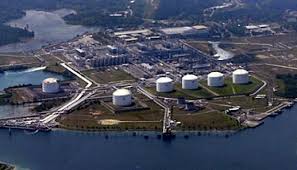BRIEF HISTORY PT. ARUN NGL

A brief History
Arun is the name of a village in the district of Syamtalira where the discovery of natural gas reserves in 1971 by Mobil Oil Indonesia Incorporation which is one of the largest natural gas resources in the world at that time. By perpetuating the name of the village then built Arun LNG located in Blang Lancang Lhok Seumawe, North Aceh, Nangroe Aceh Darussalam.
Arun gas field lies in a layer of limestone with a depth of about 3,000 m which contains about 17 trillion ft of gas with a pressure of 490 kg / cm and a temperature of about 170 0 C. Arun gas field has a length of 18.5 km, width of 5 km and 3000 m thick . The amount is expected to supply six (6) units of processing kitchen (train) with capacity of 300 million SCFD (Standard Cubic Feet Day) for a period of 20 years. The gas field consists of four gas clusters and condensate, then gas and condensate are sent to the collection unit that is point "A" which is then sent to the Arun LNG plant by pipeline:
Gas uses a 42-inch diameter pipe.
Condensate uses 16 inch diameter pipe.
LPG propan uses 20 inch diameter pipe.
The Arun LNG plant in Blang Lancang covers an area of 271 ha with a length of 1.7 km and a width of 1.5 km and is completed with a special port for transporting its production. PT Arun is a company in the form of a share with the following shares:
Pertamina -----------------------------------------------: 55 %.
Exxon Mobil ------------------------------------------ : 30%.
Japan Indonesia LNG Company -------------------: 15%.
Construction of 6 natural gas liquefaction trains at the Arun LNG plant through several stages:
Train 1,2 and 3 (Arun Project 1) were built in early 1974 and completed in late 1978 by BECHTEL Inc.
Train 4 and 5 (Arun Project II) was built in February 1982 and completed in late 1983 by CHIYODA.
Train 6 (Arun Project III) was built in November 1984 and completed in September 1986 by Japan Gas Corporation (JG C)
In February 1987 the LPG plant was built in the name of Arun LPG project done by Japan Gas Corporation (JG C) completed in 1989.
Arun LNG refinery is equipped with 2 LNG ports for delivery of its production to buyer country, while for condensate delivery is equipped with 2 pieces of loading equipment that is:
Single Point Mooring (S P M)
Multy Bouy Mooring (M B M)
Job and function.
LNG stands for Liquifeid Natural Gas defined as liquefied natural gas. Natural gas that has been liquid, its volume will shrink as much as 1/600 times the original gas volume, this is an advantage in storage and transportation. A liquefied natural gas reaching - 600 ° C shall be purified first from impurities to prevent from entering the refinery operation process, as it may interfere with the liquefaction process of the natural gas. These substances include:
Heavy Hydro Carbon compounds.
Carbon Dioxide (CO2) gas compounds.
Sulfide (H2 S).
As well as heavy gases and Mercury (Hg).
After the substances follow (impurities) apart, then the natural gas is ready for the process at a later stage.
Natural Gas Pecous.
Natural gas liquefaction is carried out on a Main Heat Exchanger by using a "Multy Component Refrigerant" (M C R) refrigerant. The content contained in MCR is: Nitrogen, Methane, Ethane, and Propane, which MCR will be cooled by Propane. While Propane itself is cooled on a heat exchanger that uses the medium of sea water.
LNG Storage and Shipment.
The LNG temperature -160 ° C is stored in special tanks with cold insulation made of 9% nike steel to resist low temperatures, and the outer walls are made of carbon steel. The Arun LNG plant has 5 LNG tank loads each with a capacity of 127,000 m3, and also has 4 condensate condensate tanks with a floating roof, with a capacity of 530,000 barrels each. And for LPG storage there are 4 pieces of storage tank where 2 tanks for propane storage and 2 more for butane storage. The capacity of each tank is 135,000 m3. Then the liquefied natural gas (L N G) will be sent through the special port available. While tankers are specially designed with a loading capacity of about 125,000 m3.
Organizational structure.
Over time PT. Arun NGL Co., carries out the process of organizational restructuring through the "work re-engineering process". The program activities involved consultants such as the Cambridge Management Consultant who was appointed by PT. Arun, and involves managing the managerial level and the section head as "Change Managenet Team". Before a new organization is developed, then set new organizational development principles based on simplifying the old work process or bureaucracy. Organization of PT. The new Arun can be viewed in the Picture where PT. Arun is led by a President Director who is the highest leader of the organization in PT Arun based in Jakarta. While PT Arun in the field led by a vice President Director (Vice President Director). The Vice President Director always reports the company's development to the President Director.
Vice President Director of the new organization oversees three divisions and three sections as follows:
Production Division
• LNG process section (LNG Process Section).
• Utilitis and Storage / Loading Section section.
• Production Planning and Engineering Section.
• Fire and Enviromental Health Service Section.
Division of Plant Operation Supporting Division
• Section of Care Planning and Reability (Maintenance Planning and Realiability Section)
• Field Area Maintenance Section.
• Maintenance Shop Section
• Procurement Section
• Information Technology Section (Information)
The Service and Development Division (Sevice and Devolopment Division)
• Scurity Service Section
• Facilities Service Section
• Section Payroll and Development (Human Resource and Development Section)
• Medical and Occupational Healty Section (Section)
• Legal Affairs Section
Public Relations Section
Finance and Accounting Section
Section of General Audit (General Audit Section)